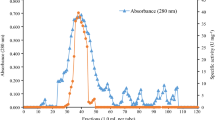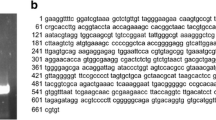Abstract
All four fungi studied attained approximately the same dry weight of mycelium in starch-yeast extract medium. Only about one-fourth the amount of mycelia was produced in yeast extract alone (starch omitted). However, the initial growth rate ofH. grisea var.thermoidea was greater than the other three fungi. Extracellular amylase was produced by all four fungi, butH. lanuginosa produced 8 to 12 times as much as the other three. Maximum extracellular amylase was found before autolysis with these three fungi, but after autolysis withH. lanuginosa. Extracellular amylase was detected in YE medium (lacking starch), but in very low amounts (approximately one-eighth the amount observed as when starch was present). Increasing the amount of starch in the medium increased extracellular amylase. However, when the starch concentration was kept constant, increasing the concentration of yeast extract had no effect on extracellular amylase.
Similar content being viewed by others
References
Bernfeld, P. (1951) Enzymes of starch degradation and synthesis.Adv. in Enzymol. 12:379–428.
Chang, Y. (1967) The fungi of wheat straw compost. II. Biochemical and physiological studies.Trans. Brit. Mycol. Soc. 50:667–677.
Crewther, W. G. &Lennox, F. G. (1953) Enzymes ofAspergillus oryzae III. The sequence of appearance and some properties of the enzymes liberated during growth.Australian J. Biol. Sci. 6:410–427.
Erb, N. M., Wisthoff, R. T. &Jacobs, W. L. (1948) Factors affecting the production of amylase byAspergillus niger strain NRRL 337, when grown in submerged culture.J. Bacteriol. 55:813–821.
Fergus, C. L. (1969) The cellulolytic activity of thermophilic fungi and actinomycetes.Mycologia 61:120–129.
Fergus, C. L. (1969) The production of amylase by some thermophilic fungi.Mycologia 61:1171–1175.
Harter, E. L. (1921) Amylase ofRhizopus tritici, with a consideration of its secretion and action.J. Agric. Res. 20:761–786.
Lemense, E. H., Corman, J., Lanen, J. M. van &Langlykke, A. F. (1947) Production of mold amylase in submerged culture.J. Bacteriol. 54:149–159.
Shu, P. &Blackwood, A. C. (1951) Studies on carbon and nitrogen sources for the production of amylolytic enzymes by submerged culture ofAspergillus niger.Canad. J. Bot. 29:113–124.
Author information
Authors and Affiliations
Additional information
Contribution No. 59 from the Botany Section, The Department of Biology. Portion of a thesis presented by the senior author in partial fulfillment for the M.S. degree.
Rights and permissions
About this article
Cite this article
Barnett, E.A., Fergus, C.L. The relation of extracellular amylase, mycelium, and time, in some thermophilic and mesophilic humicola species. Mycopathologia et Mycologia Applicata 44, 131–141 (1971). https://doi.org/10.1007/BF02051881
Issue Date:
DOI: https://doi.org/10.1007/BF02051881




